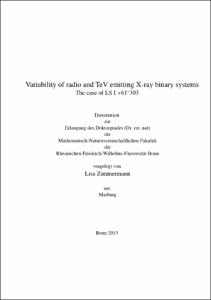Variability of radio and TeV emitting X-ray binary systemsThe case of LS I +61°303

Variability of radio and TeV emitting X-ray binary systems
The case of LS I +61°303

| dc.contributor.advisor | Massi, Maria | |
| dc.contributor.author | Zimmermann, Lisa | |
| dc.date.accessioned | 2020-04-18T23:18:25Z | |
| dc.date.available | 2020-04-18T23:18:25Z | |
| dc.date.issued | 09.09.2013 | |
| dc.identifier.uri | https://hdl.handle.net/20.500.11811/5744 | |
| dc.description.abstract | X-ray binaries contain a compact object, a black hole or a neutron star, and a normal companion star. An exclusive club of only ∼5 sources, also emits in radio and in gamma-rays. The nature of these gamma-ray binaries is strongly debated, microquasar scenarios as well as a millisecond pulsar scenario were suggested. LS I +61°303 is special even among these gamma-ray binaries, first, because it emits strongly in radio, showing periodic outbursts every ∼26.5 days and secondly because of its strong and also periodic high and very high energy emission. In this thesis, results are presented from the analysis of the variability of the radio flux density and morphology in LS I +61°303 and the connection between its variable radio and high energy emission in order to better understand the nature of this source. It is shown that earlier analysis could not have identified certain characteristics in high energy data due to the usage of too large time intervals of data. Furthermore, very high energy data from LS I +61°303 show a correlation with X-ray data reminiscent of blazars, i.e. a microblazar. This led to a re-examination of archived data from the Very Long Baseline Array (VLBA) of LS I +61°303 in search of more microblazar clues. With an improved data reduction the radio morphology shows two- and one-sided structures with fast switches and accompanied by changes in the position angle corroborating a microblazar scenario. Subsequently, a dense spectral coverage of the flare in LS I +61°303 was obtained with the Effelsberg 100m telescope, following the method used for blazar monitoring. The flare spectrum is flat, suggesting a steady jet, and is followed by several optically thin subflares, reminiscent of shocks. One of these shocks is possibly correlated with a flux rise seen in the gamma-ray regime with Fermi-LAT (Large Area Telescope). | en |
| dc.language.iso | eng | |
| dc.rights | In Copyright | |
| dc.rights.uri | http://rightsstatements.org/vocab/InC/1.0/ | |
| dc.subject | Astronomie | |
| dc.subject | Schwarze Löcher | |
| dc.subject | Röntgendoppelsterne | |
| dc.subject | Radioastronomie | |
| dc.subject | Astronomy | |
| dc.subject | Black holes | |
| dc.subject | X-ray binaries | |
| dc.subject | Radio Astronomy | |
| dc.subject.ddc | 520 Astronomie, Kartografie | |
| dc.title | Variability of radio and TeV emitting X-ray binary systems | |
| dc.title.alternative | The case of LS I +61°303 | |
| dc.type | Dissertation oder Habilitation | |
| dc.publisher.name | Universitäts- und Landesbibliothek Bonn | |
| dc.publisher.location | Bonn | |
| dc.rights.accessRights | openAccess | |
| dc.identifier.urn | https://nbn-resolving.org/urn:nbn:de:hbz:5n-33175 | |
| ulbbn.pubtype | Erstveröffentlichung | |
| ulbbnediss.affiliation.name | Rheinische Friedrich-Wilhelms-Universität Bonn | |
| ulbbnediss.affiliation.location | Bonn | |
| ulbbnediss.thesis.level | Dissertation | |
| ulbbnediss.dissID | 3317 | |
| ulbbnediss.date.accepted | 24.07.2013 | |
| ulbbnediss.fakultaet | Mathematisch-Naturwissenschaftliche Fakultät | |
| dc.contributor.coReferee | Langer, Norbert |
Dateien zu dieser Ressource
Das Dokument erscheint in:
-
E-Dissertationen (4405)




